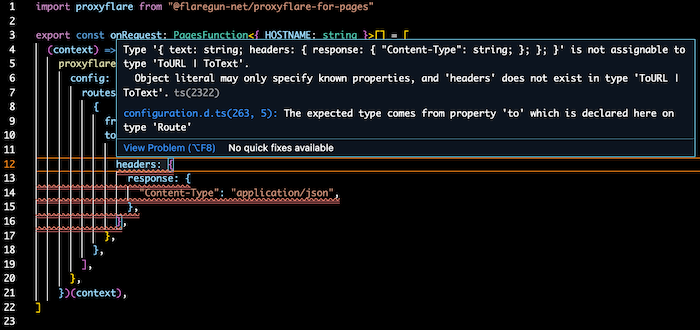How do I debug Proxyflare?
So you deployed your website deployed on Cloudflare Pages, installed Proxyflare, set up a Route, deployed a new build, and...nothing. Don't worry, we have you covered. Let's figure out what's going on with your Configuration.
We <3 Typescript
If you're using Typescript, Proxyflare includes robust type definitions to help diagnose Configuration problems before your code ships.

Using Debug Mode
Enable Debug Mode to learn how Proxyflare is operating on traffic and whether it is throwing an error.
import proxyflare from "@flaregun-net/proxyflare-for-pages"
const routes: Route[] = []
export const onRequest: PagesFunction[] = [
(context) =>
proxyflare({
config: {
// debug mode is enabled
global: { debug: true },
routes,
},
})(context),
]
When Debug Mode is on, Proxyflare appends diagnostic response headers to incoming traffic. The video below demonstrates how to find these headers in your browser's Developer Tools > Network tab.
We enabled Debug Mode to attach useful diagnostics to the response headers of our proxied traffic.
In Debug Mode, the following headers are appended to ProxiedResponse.
x-proxyflare: "running"signals that Proxyflare is installed and operational on your domain
x-proxyflare-error: stringdescribes an error if it occured, usually because of a configuration issue
x-proxyflare-matched-index: number | "none"is a zero-indexedRoutethat matched the request or "none"
x-proxyflare-matched-pathname: stringis the pathname of the matchedRoute["from.pattern"]
x-proxyflare-proxied-pathname: stringis the pathname of theProxiedRequest
Make sure to disable Debug Mode when you are done debugging to avoid exposing potentially sensitive proxy location information.
Practical debugging in Debug Mode
If your Configuration seems broken:
- Enable Debug Mode by setting
Configuration["global.debug"] = true - Deploy your change
- In your Cloudflare dashboard, confirm the deployment was successful
- Once deployed, navigate to your website and open your browser's Developer Tools > Network
- In the Network panel, open the Search window
- In Chrome, press
cmd + fon Mac orctrl + fon Windows - In Firefox, press
cmd + shift + fon Mac orctrl + shift + fon Windows
- In Chrome, press
- In the search bar, type
x-proxyflareand press Enter- You should see something like this

- You should see something like this
With this information,
- We can confirm Proxyflare is properly installed and running on our domain
- If you do not see
x-proxyflare: running, refer to the Common installation issues section
- If you do not see
- We can confirm Proxyflare is not throwing an error because
x-proxyflare-erroris absent
If x-proxyflare-error: <error message> is present, carefully inspect the error message to diagnose the issue in your Configuration. The error message might look something like this:
{
"routes": {
"0": {
"to": {
"website": {
"mode": {
"_errors": [
"Invalid literal value, expected true",
"Invalid literal value, expected \"spa\""
]
}
}
}
}
}
}
While the formatting is somewhat cryptic, we can deduce the error is in Route[0]["to.website"]. Let's look at our Configuration.
const routes: Route[] = [
{
from: { pattern: `${host}/docs/*` },
to: {
url: "https://docusaurus-on-proxyflare.vercel.app/",
website: {
mode: false,
resources: [`${host}/docs/assets/*`],
},
},
},
]
Oops! Referring to Proxyflare's type definitions, we see that Route["to.website"]: true | "spa", not false.
Fixing installation issues
Proxyflare is compatible with websites deployed on Cloudflare Pages. If your website isn't on Cloudflare Pages, Proxyflare won't work. However, it might be easier than you think to switch to Cloudflare Pages. This website is deployed on Cloudflare Pages and it was really easy!
If your website is already on Cloudflare Pages, carefully follow the instructions in the Plug In section. Ensure the file containing your Proxyflare configuration is named is exactly as instructed because Cloudflare Pages uses the filename internally for proper routing.
Once you've double checked your set up, make sure you deploy a new version of your website, and that the deployment succeeded. If you're fairly certain you're set up and in Debug Mode but still don't see x-proxyflare="running", drop us a message in Discord and we'll help figure out what's going on.